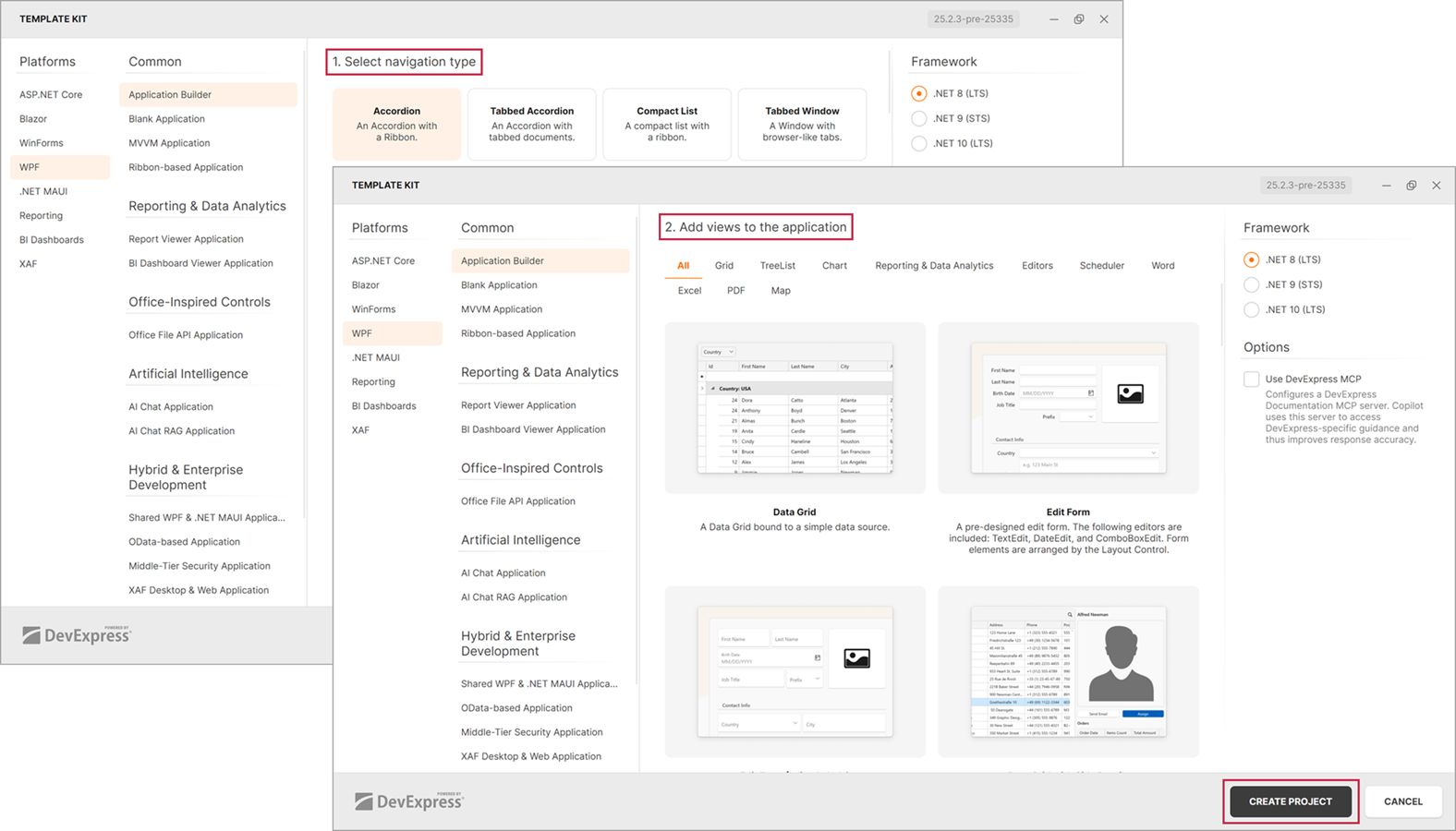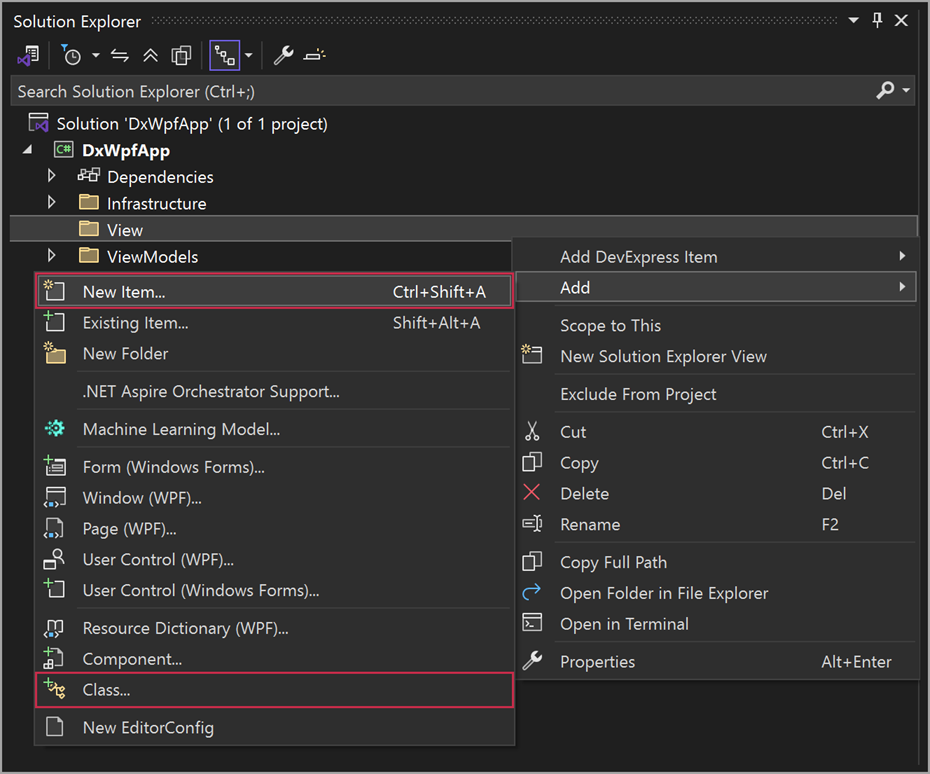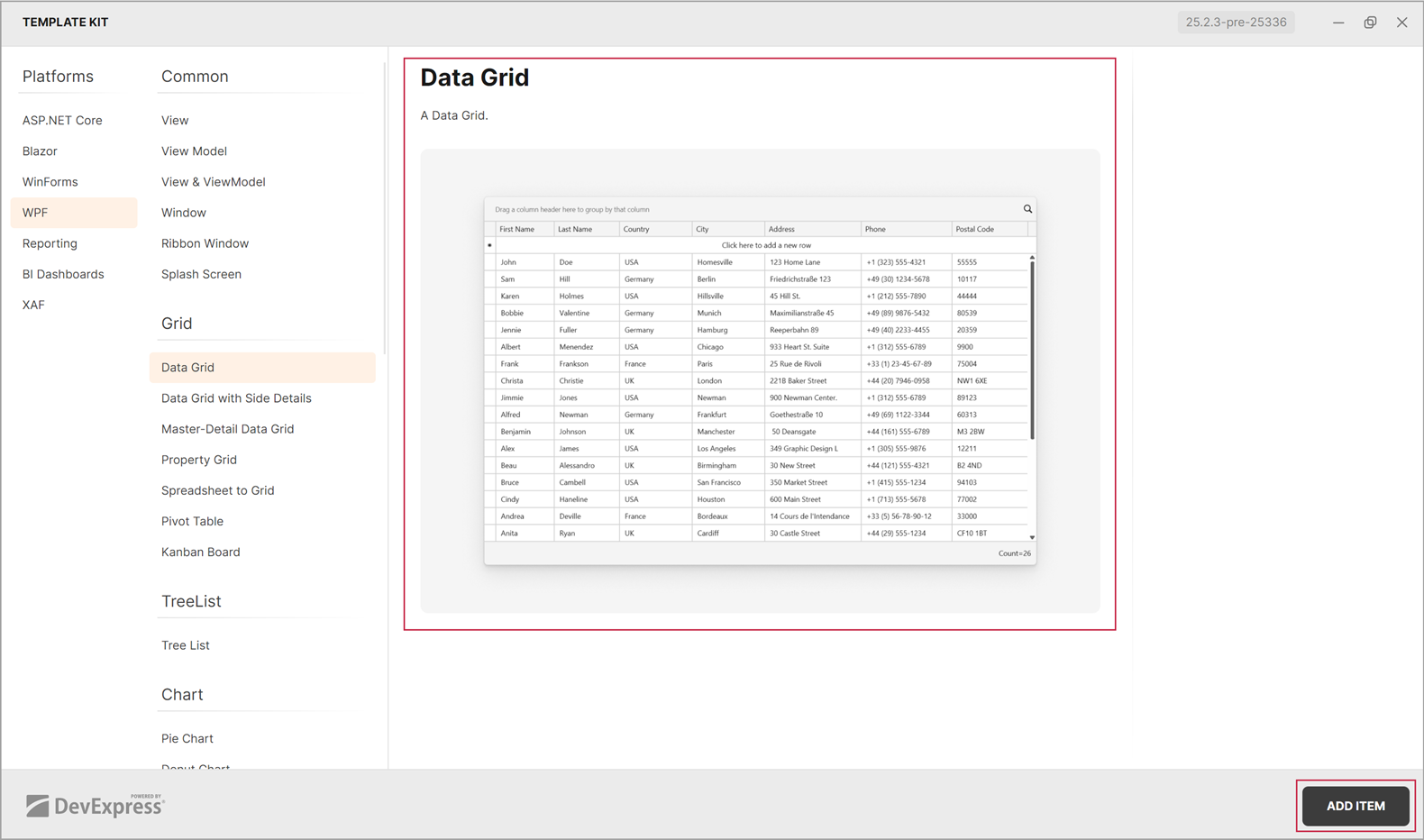Cross-IDE Template Kit
- 11 minutes to read
The DevExpress Template Kit allows you to create various starter WPF projects with built-in DevExpress UI components and libraries.

The Template Kit is based on dotnet CLI templates and is available across multiple IDEs targeting Microsoft Windows:
Note
All templates described in this article target .NET 8.0+ and support C# only.
Visual Studio
The DevExpress Template Kit for Visual Studio allows you to create a new project or add a new item to an existing project.
Install Extension
The Template Kit is available as a VSIX extension. You can install the extension for Visual Studio using one of the following options:
Run the DevExpress Unified Component Installer to add the Template Kit as a Visual Studio extension.
Use the Visual Studio Extension Manager:
- In Visual Studio, select Extensions → Manage Extensions.
- Type DevExpress Template Kit for Visual Studio in the Extension Manager search box.
- Select the extension and click Install.

Download the extension from the Visual Studio Marketplace: DevExpress Template Kit for Visual Studio.

Once ready, install the extension.
Create a New Project in Visual Studio
To create a new project, follow the steps below:
- In Visual Studio, select File → New → Project.
In the Create a new project window, select DevExpress v25.2 Template Kit and click Next.

In the Configure your new project window, specify the project name and location, and click Create.

In the Template Kit window, select the WPF platform, configure project parameters, and click CREATE PROJECT.

Add a New Item in Visual Studio
To add a new item to an existing project, follow the steps below:
In the Solution Explorer, open the context menu and select Add → New Item or Add → Class.

In the Add New Item dialog, select DevExpress v25.2 Template Kit, specify the item name, and click Add.

In the Template Kit window, select the WPF platform, choose an item template, and click ADD ITEM.

VS Code
The DevExpress Template Kit for VS Code allows you to create a new project based on a predefined template.
Install Extension
You can install the Template Kit for VS Code using one of the following options:
Use the Extensions service:
1. In VS Code, open the Extensions tab.
2. Type DevExpress Template Kit for VS Code in the search box.
3. Select the extension and click Install.

Install a separate extension from the Visual Studio Marketplace: DevExpress Template Kit for VS Code.

Create a New Project in VS Code
To create a new project using the DevExpress Template Kit, follow the steps below:
In VS Code, select File → New Window.
Open the Explorer tab and click New DevExpress Project.

Specify the project name and press Enter.

Select a project location and click the Select Folder button.
In the Template Kit window, select the WPF platform, configure project parameters, and click CREATE PROJECT.

JetBrains Rider
The DevExpress Template Kit for JetBrains Rider allows you to create new projects based on predefined templates.
Install Plugin
You can download the DevExpress Template Kit plugin for Rider at the following link: DevExpress Template Kit plugin for Rider. Once ready, install the plugin from the local file system.
Create a New Project in Rider
To create a new project using the DevExpress Template Kit, follow the steps below:
In JetBrains Rider, open the Projects tab and click New Solution.

In the New Solution dialog, select DevExpress Template Kit, specify the solution name and location, and click Create.

In the Template Kit window, select the WPF platform, configure project parameters, and click CREATE PROJECT.

Build the Project
Install the DevExpress component packages to build your project. You can use the DevExpress Unified Component Installer to add a local NuGet feed to your machine. For more information, refer to the following help topic: DevExpress Unified Component Installer.
You can also configure a personal DevExpress NuGet Feed that loads packages from the DevExpress NuGet Gallery. To do this, follow the steps below.
- Obtain your NuGet feed URL.
Register the source in your IDE or using a CLI command:
CLI Templates
You can use a command line interface (CLI) to create a new project or add an item to an existing project.
Install DevExpress CLI Templates
Execute the following command to install DevExpress WPF project templates from nuget.org:
dotnet new install DevExpress.WPF.ProjectTemplates
If you get the NU1101: Unable to find package DevExpress.WPF.ProjectTemplates error, check whether the nuget.org source is enabled. To get the list of sources with their status information, call the dotnet nuget list source command. To enable a source, call the dotnet nuget enable source <source name> command.
If you are new to NuGet, visit the following page for information on package management prerequisites: An Introduction to NuGet.
Note
DevExpress CLI templates are also available in the DevExpress NuGet Gallery (nuget.devexpress.com).
Create a New Project using CLI
To create a new project, use the following command template: dotnet new <project template short name>. In the Project Templates section, you can find short names and descriptions for all the available project templates.
The following command creates a blank WPF project called DxWpfApp in the current directory:
dotnet new dx.wpf -n DxWpfApp
You can use the following parameters to see available command options: -?, -h, --help.
dotnet new dx.wpf --help
dotnet new dx.wpf -h
dotnet new dx.wpf -?
Add a New Item using CLI
To add a new item to an existing project, use the following command template: dotnet new dx.wpf.item.<item-template-short-name> --name <view-name> -dxns <project-name>. In the Item Templates section, you can find short names and descriptions for all available item templates.
The following command adds a data grid item to the DXGridControl view within the DxWpfApp project:
dotnet new dx.wpf.item.datagrid --name DXGridControl -dxns DxWpfApp
Project Templates
The following list includes project templates available in the DevExpress.WPF.ProjectTemplates NuGet package:
- Application Builder
dx.wpf.appbuilderCreates a modular (multi-view) WPF application with a predefined navigation system. The Application Builder serves as an interactive wizard:
Step 1. Choose the primary navigation system for your application.
Step 2. Select DevExpress controls. The template automatically creates separate views for each selected UI control.
- Blank Application
dx.wpfAn application with an empty ThemedWindow.
- MVVM Application
dx.wpf.mvvmAn application based on the Model-View-ViewModel (MVVM) architectural pattern. The application supports Dependency Injection (DI) with a sample data service injected into the view model. MVVM integration is powered by the DevExpress MVVM Framework.
- Ribbon-based Application
dx.wpf.ribbonAn application with a RibbonControl and a RibbonStatusBarControl.
- Reporting Application
dx.wpf.reportingAn application with a Document Viewer that displays a predefined tabular report.
- AI Chat Application
dx.wpf.aichatA WPF chat app that integrates the AI Chat Control.
- AI Chat (RAG) Application
dx.wpf.aichatragA desktop WPF application with the AI Chat Control and built-in Retrieval-Augmented Generation (RAG) for document-grounded conversations.
- BI Dashboard Viewer Application
dx.wpf.dashboardAn application with a BI Dashboard Viewer (DashboardControl ).
- Office File API Application
dx.wpf.officefileapiAn application with an integrated DevExpress Office File API support and Office-inspired UI controls, such as Rich Text Editor, Spreadsheet, and PDF Viewer. The application mimics Microsoft Office apps designed to manage files in the following formats: DOCX/RTF, XLSX/CSV, and PDF.
- Shared WPF & .NET MAUI Application
dx.wpf.mauiA desktop app (WPF) and a mobile companion (.NET MAUI for iOS/Android) with a shared presentation and data layer (entity model, business logic, and data service). The applications support Dependency Injection (DI) and Model-View-ViewModel (MVVM) architectural patterns.
- OData-based Application
dx.wpf.odataAn application with a secure data layer powered by ASP.NET Core OData, EF Core, and XAF’s Backend Web API Service. The additional layer of protection (authentication, authorization, and encryption) prevents desktop UI clients from accessing database connection information or modifying database tables directly.
- Middle-Tier Security Application
dx.wpf.middletierAn application with a secured data layer powered by ASP.NET Core WebAPI, EF Core and XAF’s Middle-Tier Application Server (requires the Universal subscription). This additional layer of protection (authentication, authorization, and encryption) prevents desktop UI clients from accessing database connection information or modifying database tables directly. Developers can also maintain an existing data context (DbContext) and business logic while establishing remote/secure connections to an RDBMS-based data store.
- Tabbed MDI Application
dx.wpf.mdiAn application that uses the DevExpress Module Injection Framework and a Tabbed MDI interface. A DevExpress Dock Layout Manager creates dockable tabs and navigation panels. At runtime, users can drag tabs from the main form to create individual forms.
All WPF project templates support DevExpress themes/styles.
Item Templates
The following list includes item templates available in the DevExpress.WPF.ProjectTemplates NuGet package:
Common
- View
dx.wpf.item.viewCreates a View (User Control) in an MVVM pattern.
- View Model
dx.wpf.item.viewmodelCreates a blank View Model in an MVVM pattern.
- View & ViewModel
dx.wpf.item.viewviewmodelCreates a View & ViewModel in an MVVM pattern.
- Window
dx.wpf.item.windowCreates a new Window.
- Ribbon Window
dx.wpf.item.ribbonCreates a new Window with a Ribbon UI.
- Splash Screen
dx.wpf.item.splashscreenCreates a splash screen window that can serve as a wait indicator during a time-consuming task, such as application startup.
Grid
- Data Grid
dx.wpf.item.datagridCreates a Data Grid.
- Data Grid with Side Details
dx.wpf.item.gridsidedetailCreates a Data Grid with a side panel that displays detail information for the selected item.
- Master-Detail Data Grid
dx.wpf.item.gridmasterdetailCreates a Data Grid with embedded detail tables.
- Property Grid
dx.wpf.item.propertygridCreates a Property Grid bound to an object that contains a collection and custom property types.
- Spreadsheet to Data Grid
dx.wpf.item.spreadsheettogridCreates a component that supplies Spreadsheet data to a Data Grid.
- Pivot Table
dx.wpf.item.pivotCreates a Pivot Grid bound to a sample data source.
- Kanban Board
dx.wpf.item.kanbanCreates a Kanban Board (a Grid Control that uses a custom row template).
Tree List
- TreeList
dx.wpf.item.treelistCreates a Tree List bound to a hierarchical data source.
Chart
- Pie Chart
dx.wpf.item.piechartCreates a Pie Chart with a detail panel on the right-hand side.
- Donut Chart
dx.wpf.item.donutchartCreates a Donut Chart with a detail panel on the right-hand side.
- Bar Chart
dx.wpf.item.barchartCreates a Bar Chart with a detail panel on the right-hand side.
- Stacked Bar Chart
dx.wpf.item.stackedbarchartCreates a Stacked Bar Chart with a detail panel on the right-hand side.
- Area Chart
dx.wpf.item.areachartCreates an Area Chart with date range selector that uses dropdown calendars.
- Stacked Area Chart
dx.wpf.item.stackedareachartCreates an Stacked Area Chart with a date range slider control.
- Diagram
dx.wpf.item.diagramCreates a Diagram Control that displays bound data as an organizational chart.
Reporting & Data Analytics
- Report
dx.wpf.item.reportCreates an empty DevExpress Report that can be customized at design time.
- Dashboard
dx.wpf.item.dashboardCreates an empty DevExpress Dashboard that can be customized at design time.
Editors
- Edit Form
dx.wpf.item.editformCreates a sample edit form that uses the DevExpress Layout Control to arrange individual editors and their labels.
- Edit Form (Inline Labels)
dx.wpf.item.editforminlinelabelsCreates a sample edit form that uses the DevExpress Layout Control to arrange individual editors. Editors display inline labels.
- Barcode Generator
dx.wpf.item.barcodeCreates a text-to-barcode converter (requires the DevExpress Office File API library).
Scheduler
- Scheduler
dx.wpf.item.schedulerCreates a Scheduler Control bound to a data source with multiple calendars.
Office-Inspired Controls
- Rich Text Editor
dx.wpf.item.richeditorCreates a Rich Text Editor with a Word document loaded asynchronously.
- Word to PDF Converter
dx.wpf.item.wordtopdfA module that converts a Word file to PDF.
- Mail Merge
dx.wpf.item.mailmergeA module that implements mail merge. Office File API binds data to a template Word document to generate an output document.
- Spreadsheet
dx.wpf.item.spreadsheetA Spreadsheet with an Excel document loaded asynchronously.
- Spreadsheet Writer
dx.wpf.item.populatespreadsheetA module that efficiently generates a large Excel file.
- PDF Viewer
dx.wpf.item.pdfviewerA PDF Viewer with a sample PDF document specified in a view model.
- Excel to PDF Converter
dx.wpf.item.spreadsheettopdfA module that converts an XLSX file to PDF.
- Merge PDFs
dx.wpf.item.mergepdfA module that merges two PDF files.
Map
- Map
dx.wpf.item.mapCreates a Map Control with shape and pie chart vector layers.
Gantt
- Gantt
dx.wpf.item.ganttCreates a Gantt Control bound to a hierarchical data source.
Common Parameters for Item Templates
- Common Parameters
-dxns/--dx-item-namespaceThe default namespace for a newly created item and its elements.
Additional Command Line Parameters
The following list contains available options you can specify when using DevExpress WPF templates:
-prerelease,--use-prerelease-dx-version- A flag that indicates if a pre-release DevExpress package version should be used in the project.
--framework <TFM>- Specifies the target framework. The command expects a target framework moniker (TFM). Examples:
net8.0,net8.0-windows. --dx-version <version>- Specifies DevExpress package version to be used in the project. Examples:
24.2.3,25.2.*,25.2.*-* --dx-nuget-feed <feed>- Specifies the NuGet Feed URL. Refer to nuget.devexpress.com to obtain your personal feed URL (available for registered users).
-preload,--preload-resourcesPreload theme resources on application startup to reduce the loading time for all subsequent windows. For additional information, refer to the following help topic Preload Theme Resources.
Default:
true-lwthemes,--lightweight-themesUse DevExpress lightweight themes instead of regular themes. For additional information, refer to the following help topic: Lightweight Themes.
Default:
true